
On any list of the most beautiful cars of the Sixties, the Miura would inevitably be found close to the top.
The Lamborghini Miura was Marcella Gandini's first project for Italian styling house, Bertone before he went on to seal his reputation by creating the Lamborghini Countach, as well as top-selling models for Lancia and BMW.
Reportedly 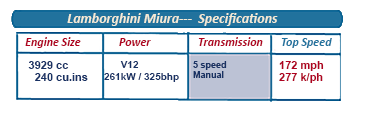 overwhelmed by the young Gandini’s designs, Lamborghini enthusiastically gave the go-ahead for development of the Miura, naming it after a breed of fighting bull.
overwhelmed by the young Gandini’s designs, Lamborghini enthusiastically gave the go-ahead for development of the Miura, naming it after a breed of fighting bull.
From then on, the charging bull emblem used on the Miura was to appear on all Lamborghinis released.
A more potent version of the 3929-cc engine created for the 400 GT went into the new Miura, which served as Lamborghini's first transverse mid-engine model.
In this format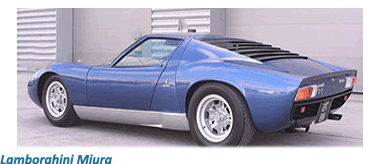 , the V-12 generated 350 horsepower and 279 pound-feet of torque, for a top speed around 160 mph.
, the V-12 generated 350 horsepower and 279 pound-feet of torque, for a top speed around 160 mph.
The Miura was first shown as a chassis, complete with engine, at the Turin Motor Show in November 1965.
Designed and constructed around a mid-mounted V12 engine, set behind the cockpit but within the wheelbase, the Miura engine was short enough to be turned through 180 degrees and mounted on the chassis.
Having such a powerful engine fitted in such a position called for some innovate space managagement.
Lamborghini solved the problem by designing a new transmission, designed on the same principle used by Sir Alec Issigosis on the BMC Mini, where the gearbox sat beneath the engine, sharing its oil.
![]()
The Miura’s exhaust systems were complicated, as the lack of longitudinal space meant that transverse silencers had to be used.
Suspension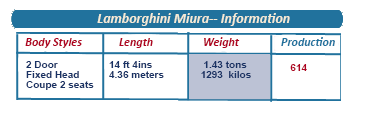 was by double wishbones with coil springs/dampers front and rear, andan anti-roll bar fitted at each end.
was by double wishbones with coil springs/dampers front and rear, andan anti-roll bar fitted at each end.
Following the positive response received by the Miura chassis debuted at the 1965 Turin show, a complete car appearing the next spring at the Geneva (Switzerland) event, although intended as a show car rather than a pre-production version.
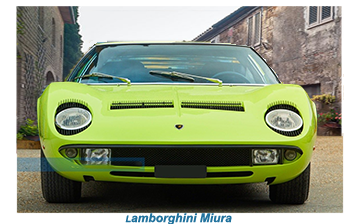 According to press report of the time, the lithe, sinuous body of the Miura left all other models on show Geneva in the shade, and it soon went into production,
According to press report of the time, the lithe, sinuous body of the Miura left all other models on show Geneva in the shade, and it soon went into production,
A pointed snout and sharp-edged rear end helped give the car a shallow look.
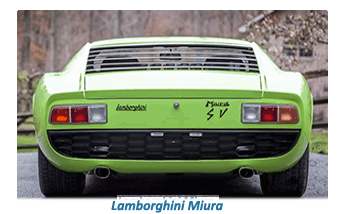
An air-intake grid served as part of the door, to the rear of the side window.
Rear window louvres were part of the package.
'Lamborghini' and 'Miura' script were prominently placed on the coupe's back panel, alongside the tail lamps.
![]()
The Miura was an eye-catching car with the clever use of a contrasting colour below the sill line matched up with neat little scoops for cooling air for the rear brakes giving a dramatic effect.
The rear edge of each door had intakes which passed air through the pillars, where it was deflected to the filters, thus ensuring a cold air supply to the engine.
Lamborghini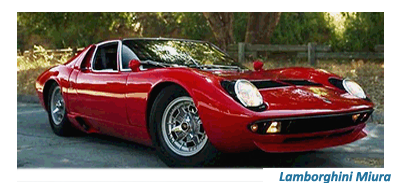 produced a total of 475 Miuras in its original format before updating it in 1969.
produced a total of 475 Miuras in its original format before updating it in 1969.
To differentiate between the two versions, Lamborghini named the latest one the Miura S, with the most significant change over the original models was using a heavier gauge of steel on the car’s chassis.
The point behind the increased metal thickness (up to 1 mm from 0.9 mm) was to reduce levels of flexing, particularly when cornering at high speed.
Today, the Miura remains among the ultimate Sixties vehicles, retaining its credentials as one of the most stunning sports cars of all time.






